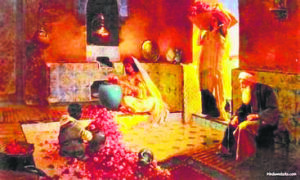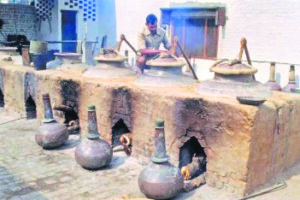


The word perfume is used today to describe scented mixtures and is derived from the Latin word, “per fumus,” meaning through smoke. The word perfumery refers to the art of making perfumes. Perfume was refined by the Romans, the Persians and the Arabs.
Although perfume and perfumery also existed in East Asia, much of its fragrances were incense based. But history of Indian perfumes holds a unique significance in the world history. Today we will deep dive and understand the very beginning of the perfume culture in the country and also its journey through ancient India to the modern one.
According to a 1975 report, archaeologist Dr Paolo Rovesti found a terracotta distillation apparatus in the Indus valley together with oil containers made of the same material, carbon dated to 3000 BCE. Many evidences and scriptures mentioning the importance and use of fragrant material as perfumes and scents since ages in Indian culture and tradition have been reported. Perfumes are generally applied to pulse points such as the wrists, neck, and behind the ears. Comes in various forms, including eau de parfum, eau de toilette, and more.
Mandu in Madhya Pradesh has a history filled with pursuits of pleasure in the form of a book called “The Ni’ Matnama or the book of Delights shared by William Dalrymple in his talk show titled “Scent and sensuality in India” at The Desert Museum Perfume and perfumery also existed in Indus civilization, which existed from 3300 BCE to 1300 BCE.
One of the earliest distillations of Ittar was mentioned in the Hindu Ayurvedic text “Charaka Samhita” and “Sushruta Samhita”. The perfume references are part of a larger text called Brihat-Samhita written by Varahamihira, an Indian astronomer, mathematician, and astrologer living in the city of Ujjain. He was one of the ‘nine jewels’ in the court of the Maharaja of Malwa. Different types of perfumed articles, their natural sources, method of preparation, etc., have been treated in this text under the heading “Gandhayukti”, a term which stands for the art and science of perfumery. The perfume portion mainly deals with the manufacture of perfumes to benefit ‘royal personages and inmates of harems’. The text is written as Sanskrit shlokas with commentary by a 10th-century Indian commentator Utpala.
According to the International Journal of Creative Research Thoughts’ research paper on Indian History Of Perfume, Its Evidences And Evolution From Different Era, the art and science behind the perfume and scented articles is not new to India, and that perfumery had developed as a science in ancient India and our country has contributed nothing less to this branch of science which now has reached a very advanced stage.
Evidence of perfumes and scented materials in Vedas
The Vedas are the earliest literary records of the Aryans. Since our main source of information about the Aryans is Vedic literature, this period is also called the Vedic age. The early Vedic period extends from 1500 BC to 1000 BC. There are four Vedas: the Rig Veda, the Yajur Veda, the Sama Veda and the Atharva Veda. The Vedas are generally admitted to be the source of Indian philosophical thought, religious practices, social customs, professions and functions of different social classes. In short Vedas are considered as almost all spiritual and secular conventions, observations and pursuits. Varied usages of perfumes along with individual beautification and medicinal purposes can be seen in Vedic literatures.
In Rigveda-Srak is used for flower garlands and Aswins were called as Pushkarasrajau, wearing garlands of Lilies. Om Tryambakam yajamahe sugandhim pushtivardhanam, Urvaarukamivabandhanaan mrutyormukshiya maamrutat. (Rigveda. 59.12.1) (The word Sugandhi is used for Agni (the god of fire), well-wisher of men, who carries the oblations with his redolent-mouth.
The fragrant mouthed Agni was also considered as augmenter of material prosperity and ensures of immortality through divine grace).
In Rig-Veda collyrium (Anjana), perfumed unguents (Punya gandha or Surabhi), beautiful garments and flower garlands (Suvasah) were mentioned. The word Punya gandha was also mentioned in Atharvaveda. Striyo yah punyagandhastahsarvahsvapayaamsi (Rigveda.55.8)
In Atharvaveda use of fragrant drugs like licorice (Glycyrrhiza glabra Linn.), Kushta (Saussurealappa C.B. Clarke ); Nalada (Vetiveria zizanioides Linn.) etc. were mentioned. In Atharvaveda, Kushta (Saussurealappa C.B. Clarke – a scented rhizome) was mentioned in many hymns as an important drug to relieve many diseases and to provide eternal life.
Purana is a vast genre of Indian literature about a wide range of topics, particularly about legends and other traditional lore. Several of these texts are named after major Hindu deities such as Vishnu, Shiva, Brahma and Shakti. The Puranic genre of literature is found in both Hinduism and Jainism.
The Puranic literature includes diverse topics such as cosmogony, cosmology, genealogies of gods, goddesses, kings, heroes, sages, and demigods, folk tales, pilgrimages, temples, medicine, astronomy, grammar, mineralogy, humor, love stories, as well as theology and philosophy. The content is highly inconsistent across the Puranas, and each Purana has survived in numerous manuscripts which are themselves inconsistent. The Hindu Maha Puranas are traditionally attributed to “Vyasa”.
Many other scattered references of the use of perfumed water, scented waters, scented oils, scented powders and other cosmetics can be observed in Valmiki Ramayana and also in Mahabharata. During these periods lamps were filled with perfumed oils; fragrant powders were used for face and body; bed sheets were variegated and scented; arrows and weapons were worshiped by applying sandal paste and decorating with flower garlands.
In pre Buddhist period, people were trained in sixty four arts. Gandhayukti (The art of blending perfumes) is one among them. Lalitavistara mentioned that the young Bodhisattva had excelled in sixty four arts. Five Sikkhapadas of Khuddaka Pada contain few restrictions for Buddistic monks. The monks are prohibited from use of pomade (Perfume oil), perfumes and anointing the body.

In another Buddhist text in Pali, namely, Brahmajala sutta, a list of procedures for bedecking, dressing, Uccaadana (anointing with perfumes), MaalaaVilepana (applying pomade and anointing and wearing flower garlands), Mukhacunaka (applying fragrant talcum powder to face) etc. were described.
Contemporary Indian Literature
Kautilya’s Arthashastra
Kautilya’s Arthashastra is an ancient Indian Sanskrit treatise. The term ‘Arthashastra’ means textbook of Statecraft, economic policy, and military strategy. Arthashastra has the descriptions of many fragrant drugs, which were used as cosmetics like Sandalwood, Agaru (Aquilaria agallocha) and TailaParnika (Eucalyptus). Chandana (Sandalwood) was used as Anulepana (external application) and as beauty aid and fragrant material. Qualities of Sandalwood were mentioned as light, soft, moist (Asyana, not dry) as greasy as ghee, pleasant smell, adhesive to the skin, absorptive of heat, and comfortable to the skin.
The perfume industry in ancient India was rich and diverse, reflecting the country’s deep cultural and historical roots. Here are some interesting facts about the perfume industry in old India:
Use of Natural Ingredients
Perfumes in ancient India were primarily made from natural ingredients such as flowers, herbs, spices, and essential oils. These ingredients were often sourced locally and were known for their aromatic and therapeutic properties.
Development of Attars
Attar, also known as Ittar, is a traditional Indian perfume that dates back to ancient times. The art of making attar involves the distillation of flower petals, herbs, and spices into a fragrant oil. Popular attars included rose, jasmine, sandalwood, and agarwood. Indian perfumers used exotic and rare ingredients in their formulations. Agarwood (oud), derived from the Aquilaria tree, was highly prized for its rich and distinctive fragrance. It was often used in the creation of high-quality perfumes.
Ayurvedic Influence
The use of fragrances in ancient India was deeply connected to Ayurveda, the traditional system of medicine. Fragrant herbs and oils were not only valued for their pleasant scents but also for their perceived therapeutic benefits.
Religious Significance
Perfumes held significant importance in religious rituals and ceremonies. Aromatic substances were often used in temples and during religious ceremonies to create a sacred atmosphere. The use of incense and fragrant oils was a common practice.
Mughal Patronage
The Mughal rulers, who had a profound influence on Indian culture and society from the 16th to the 19th centuries, were great patrons of the perfume industry. They brought with them a love for luxurious scents and contributed to the refinement of perfume-making techniques.
Distinct Regional Styles
Different regions of India developed their own unique styles of perfumery, influenced by local flora and cultural preferences. For example, Kannauj in Uttar Pradesh became renowned for producing traditional Indian attars.
Trade and Cultural Exchange
India’s strategic location along the ancient trade routes facilitated the exchange of perfumes and aromatic materials with other civilizations, including those in the Middle East and Southeast Asia. This cultural interchange influenced the evolution of Indian perfumery.
Personal Grooming and Social Customs
Perfumes were not only associated with religious rituals but also played a role in personal grooming and social customs. The use of fragrances was considered a sign of refinement and status, and it was common for people to apply perfumes on special occasions.
Traditional Techniques
Perfume-making in ancient India involved traditional techniques such as distillation and enfleurage. These methods were passed down through generations and contributed to the unique and artisanal nature of Indian perfumery.

The perfume industry in old India was characterized by a deep appreciation for natural scents, a connection to traditional healing practices, and a cultural significance that extended beyond personal adornment. The legacy of these ancient perfume traditions continues to influence modern perfumery in India today.
Places of Ittar
Production in India
Ittar or attar is derived from natural sources such as flowers, herbs, and spices. The production of ittar is an ancient and highly skilled craft, and it is associated with specific regions in India known for their expertise in perfumery. Some of the notable regions where ittar is produced in India include:
Kannauj, Uttar Pradesh: Kannauj is often considered the perfume capital of India. It has a long-standing tradition of producing attars using traditional methods of distillation. Rose, jasmine, sandalwood, and agarwood attars are particularly famous from this region.
Kasauli, Himachal Pradesh: Kasauli, nestled in the Himalayan foothills, is known for producing natural fragrances and essential oils. The cool climate and abundant flora contribute to the production of high-quality attars.
Bhavnagar, Gujarat: Bhavnagar in Gujarat is known for its production of traditional Indian attars. The region is especially renowned for its rose attar, which is extracted from the Rosa damascena variety of roses.
Basti, Uttar Pradesh: Basti, located in Uttar Pradesh, is another region with a history of attar production. The craft has been passed down through generations, and attars from this region often feature a blend of various aromatic ingredients.
Bengaluru, Karnataka: Bengaluru, in the southern state of Karnataka, has a growing market for natural perfumery. The city is known for its production of sandalwood-based attars, taking advantage of the region’s sandalwood resources.
Madurai, Tamil Nadu: Madurai, in the southern state of Tamil Nadu, is famous for its jasmine cultivation. The city is known for producing exquisite jasmine attars, capturing the fragrance of the locally grown flowers.
Aurangabad, Maharashtra: Aurangabad in Maharashtra is known for its production of various traditional Indian perfumes, including attars. The region benefits from a diverse range of aromatic plants and flowers.
Varanasi, Uttar Pradesh: Varanasi, one of the oldest cities in the world, has a tradition of producing attars. The attars from this region often incorporate elements of spirituality and are used in religious ceremonies.
These regions showcase the diverse geographical and climatic conditions of India, contributing to the variety of attars produced across the country. Each region has its unique expertise, and the traditional methods of attar production continue to be preserved and passed down through generations.